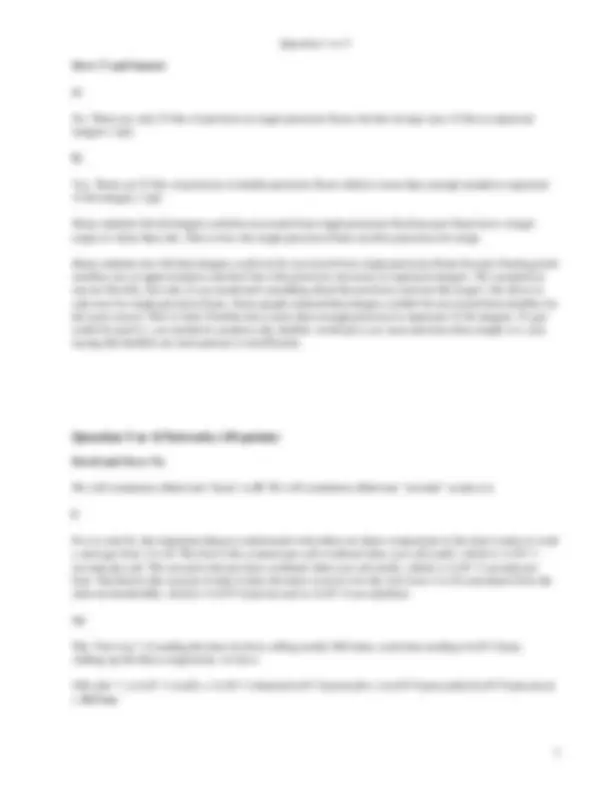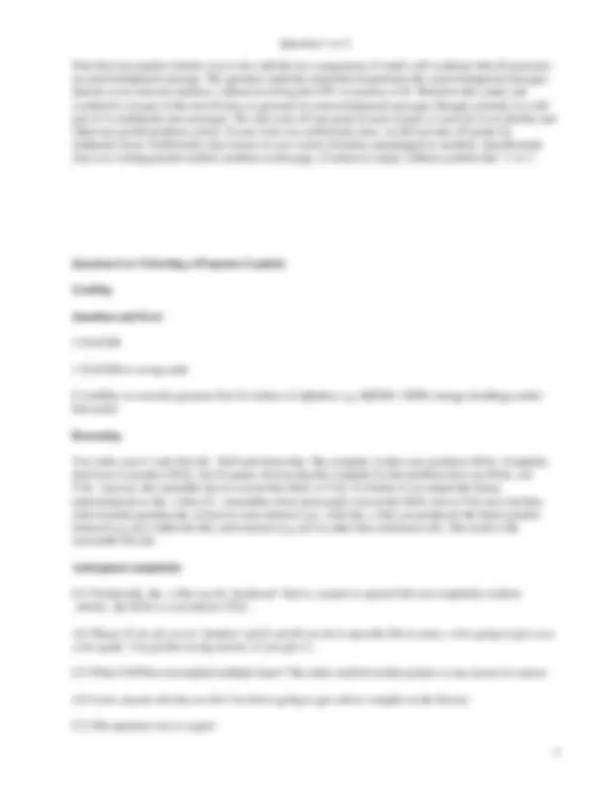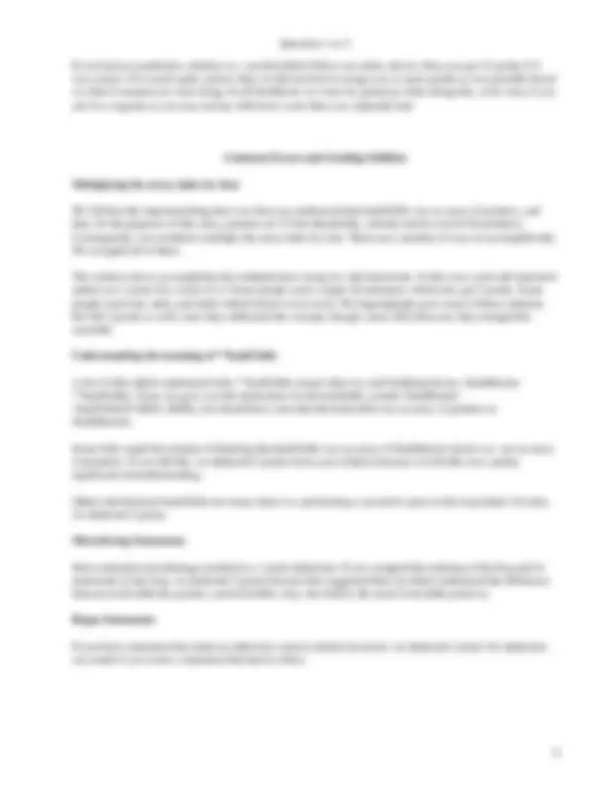






Study with the several resources on Docsity

Earn points by helping other students or get them with a premium plan


Prepare for your exams
Study with the several resources on Docsity

Earn points to download
Earn points by helping other students or get them with a premium plan
Community
Ask the community for help and clear up your study doubts
Discover the best universities in your country according to Docsity users
Free resources
Download our free guides on studying techniques, anxiety management strategies, and thesis advice from Docsity tutors
Information about various computer science concepts including parts of a computer, pointers, floating point numbers, networks, and starting a program. It includes examples, grading rubrics, and common mistakes. Students may find this document useful for understanding these topics and preparing for exams or assignments.
Typology: Exams
1 / 8

This page cannot be seen from the preview
Don't miss anything!





Question 1 or 2: Parts of a Computer (3 points)
Jonathan and Kurt
a)
control datapath memory input output
Minus one point for every answer that wasn't there, up to a maximum of two. We
grudgingly accepted 'CPU' for control.
b)
We accepted just about any answer that was remotely reasonable. One point was given if at least 3 of the 5 made sense.
Question 2 or 5: Pointers (5 points)
Jonathan and Kurt
All the parts were graded on an all or nothing basis.
a)
'la $s0, x' 'li $s0, 1000'
We accepted anything that loaded 1000 into $s0.
b)
'la $s1, y' 'li $s1, 1004'
We accepted anything that loaded 1004 into $s0.
c)
'lbu $t0, 0($s0) sb $t0, 0($s1) addiu $s0, $s0, 1'
We also accepted 'lb' for 'lbu'. However, we did not accept 'addi' for 'addiu'.
d)
'mov $s1, $s0' 'add $s1, $s0, $0'
We accepted anything that copied $s0 into $s1.
e)
1001
Question 3 or 1: Pliable Data (5 points)
Kurt, Jonathan
The first three parts were graded on a all or nothing basis.
a)
0010 0000 1100 1000 10001 0000 0000 0000
b)
c)
[ 1 + 2^(-1) + 2^(-4) + 2^(-8) + 2^(-11) ] x 2^(-62)
d)
'addi $8 $6 -28672' 'addi $t0 $a2 -28672'
One point for addi and the registers. One point for the immediate. We accepted any signed sum of powers of two that added to -28672. The most succinct was 2^12 - 2^15.
Question 4 or 6: Can a C integer float? (2 points)
Note that the wording of the problem did not technically require you to count the amount of time it takes the data to travel over the wire from A to B, so we also gave full credit for
500 calls * [ (1x10^-3 s/call) + (1x10^-5 s/byte)(4x10^3 bytes/call) ] = 20.5 sec.
(b)
The "second way" of sending the data involves calling send() 1 time, sending 2x10^6 bytes all at once. Adding up the three components, we have
1 call * [ (1x10^-3 s/call) + (1x10^-5 s/byte)(2x10^6 bytes/call) + (2x10^6 bytes/call)/(5x10^5 bytes/sec)] = 24.001 sec.
Note that the wording of the problem did not technically require you to count the amount of time it takes the data to travel over the wire from A to B, so we also gave full credit for
1 call * [ (1x10^-3 s/call) + (1x10^-5 s/byte)(2x10^6 bytes/call) ] = 20.001 sec.
For (c) and (d), we add two new components to the amount of time needed to send a message from A to B. The first new component is the constant per-message time it takes B to generate an acknowledgment message, which is 1 x 10^-3 sec, and the second new component is the amount of time it takes the acknowledgment message to travel over the wire from B to A (calculated from the network bandwidth), which is 5x10^ bytes/second or 2x10^-6 seconds/byte. There is one acknowledgment message sent by B for each send() call that A does.
(c)
The extra time added by the generation and transmission of the acknowledgment is
500 acknowledgment messages * [1 x 10^-3 s/message + (1 x 10^4 bytes/acknowledgement message)/(5x10^5 bytes/s)] = 10.5 sec.
Therefore the total time is whatever you got in part (a) plus 10.5 sec, so we accepted 24.5+10.5 = 35.0 sec or 20.5+10.5 = 31.0 sec.
(d)
The extra time added by the generation and transmission of the acknowledgment is
1 acknowledgment message * [1 x 10^-3 s/message + (1 x 10^4 bytes/acknowledgement message)/(5x10^ bytes/s)] = 0.021 sec.
Therefore the total time is whatever you got in part (b) plus 0.021 sec, so we accepted 24.001 + 0.021 = 24.022 sec or 20.001 + 0.021 = 20.022 sec.
Note that one popular mistake was to also add the two components of send() call overhead when B generates an acknowledgment message. The question explicitly stated that B generates the acknowledgment messages directly on its network interface, without involving the CPU or memory of B. Therefore this send() call overhead is not part of the time B takes to generate its acknowledgment messages (though certainly it is still part of A sending the true message). We only took off one point in each of parts (c) and (d) if you did this and otherwise got the problem correct. If your work was sufficiently clear, we did not take off points for arithmetic errors. Sufficiently clear means we saw correct formulas and plugged-in numbers. Insufficiently clear was writing pseudo-random numbers on the page, of unknown origin, without symbols like '+' or '('.
Question 6 or 3: Starting a Program (2 points)
Grading
Jonathan and Kurt
2: EACDB
1: EACDB in wrong order
0: inability to correctly generate first five letters of alphabet, e.g. JQFMD, 10000, strange doodlings and/or bite marks
Reasoning
You write your C code first (E). 'Nuff said about that. The compiler, in this case, produces MAL. Compilers don't have to produce MAL, but it's pretty obvious that the compiler for this problem does use MAL, not TAL. Anyway, the assembler has to convert this MAL to TAL (A) before it can output the binary representations to the .o files (C). Assemblers don't necessarily convert the MAL text to TAL text, but they must translate pseudocode, at least in some abstract way. After the .o files are produced, the linker patches internal (e.g. jal's within the file) and external (e.g. jal's to other files) references (D). The result is the executable file (B).
Anticipated complaints
C1) Technically, the .o files can be "produced," that is, created or opened (but not completely written) before the MAL is converted to TAL!
A1) Please. If we ask you to "produce" proj5 and all you do is open the file in emacs, we're going to give you a low grade. You got the wrong answer, so you got a 1.
C2) What if M'Piero recompiled multiple times? The order could be totally jacked, so any answer is correct.
A2) Look, anyone who has an ALU for feet is going to get code to compile on the first try.
C3) This question was so vague!
Question 8: Pointers in C and MIPS (14 points)
Solution, Lan 'n Dan
Underlined lines are the lines you had to fill it. We also gave you the option of writing your own solution from scratch, though I don't recall seeing anyone who chose this option.
findData: addi $sp, $sp, - sw $a0, 16($sp) sw $a1, 20($sp) sw $ra, 24($sp) jal hashFunction lw $a0, 16($sp) lw $a1, 20($sp) lw $ra, 24($sp) addi $t0, $0, TABLE_SIZE # Pretend TABLE_SIZE is a constant divu $v0, $t mfhi $t0 # $t0 = hashFunction(key) % TABLE_SIZE add $t0, $t0, $t0 # $t0 = 2 x location add $t0, $t0, $t0 # $t0 = 4 x location add $t0, $t0, $a1 # $t0 = &hashTable[location] lw $t0, 0($t0) # $t0 = hashTable[location] loop: beq $t0, $0, not_found # while(lookAtMe != NULL) lw $t1, 0($t0) # $t1 = lookAtMe->key bne $t1, $a0, next_bucket # if(lookAtMe->key == key)...
lw $v0, 4($t0) # $v0 = lookAtMe->value j fin next_bucket: lw $t0, 8($t0) # lookAtMe = lookAtMe->next j loop not_found: addi $v0, $0, ERROR_NOT_FOUND # Pretend ERROR_NOT_FOUND is a
fin: addi $sp, $sp, 28 jr $ra
Grading
The problem was out of 14 points. If your solution was correct, you got all 14 points. Otherwise, we assigned 2 points for each correct line you filled in. If you had a line basically correct, but got a single register wrong or made a similar typo-esque mistake, we docked you 1 point so you'd get 1/2 points for the line.
If you had an unorthodox solution (i.e. one that didn't follow our rubric above), then you got 14 points if it was correct. If it wasn't quite correct, then we did our best to assign you as many points as was possible based on what it seemed you were doing. In all likelihood, we were too generous when doing this, so be wary if you ask for a regrade as you may end up with lower score than you originally had.
Common Errors and Grading Oddities
Multiplying the array index by four
We felt that the important thing here was that you understood that hashTable was an array of pointers, and that, for the purposes of this class, pointers are 32 bits (thankfully, nobody tried to use 64-bit pointers). Consequently, you needed to multiply the array index by four. There are a number of ways to accomplish this. We accepted all of them.
The solution above accomplishes the multiplication using two add statements. In this case, each add statement netted you 1 point (for a total of 2). Some people used a single sll statement, which also got 2 points. Some people used mul, mult, and multi (which doesn't even exist). We begrudgingly gave most of these solutions the full 2 points as well, since they addressed the concept, though, more often than not, they munged the assembly
**Understanding the meaning of hashTable
A lot of folks didn't understand what **hashTable meant when we said findData(int key, HashBucket **hashTable). Since we gave you the declaration for the hashtable, namely HashBucket *hashTable[TABLE_SIZE], you should have seen that the hash table was an array of pointers to HashBuckets.
Some folks made the mistake of thinking that hashTable was an array of HashBucket structs (i.e. not an array of pointers). If you did this, we deducted 3 points from your solution because we felt this was a pretty significant misunderstanding.
Others dereferenced hashTable too many times (i.e. performing a second lw prior to the loop label). For this, we deducted 2 points.
Misordering Statements
Most statement misorderings resulted in a 1 point deduction. If you swapped the ordering of the beq and lw statements in the loop, we deducted 2 points because this suggested that you didn't understand the difference between lookAtMe the pointer, and lookAtMe->key, the field in the struct lookAtMe points to.
Bogus Statements
If you had a statement that made an otherwise correct solution incorrect, we deducted 1 point. No deduction was made if you wrote a statement that had no effect.